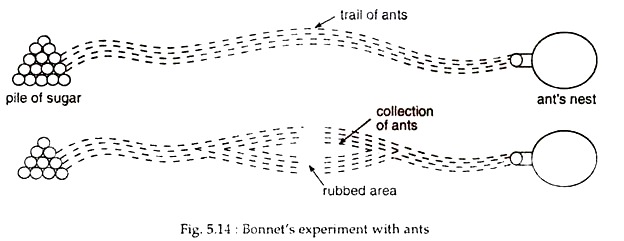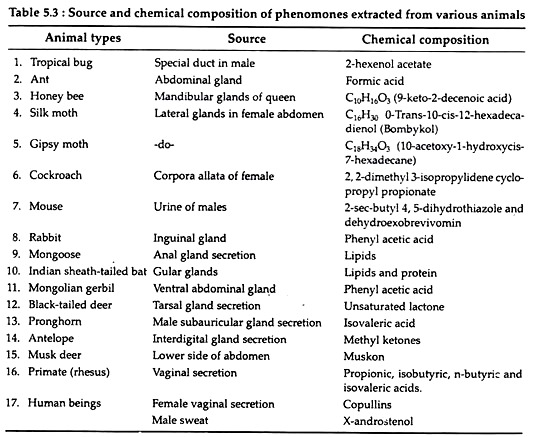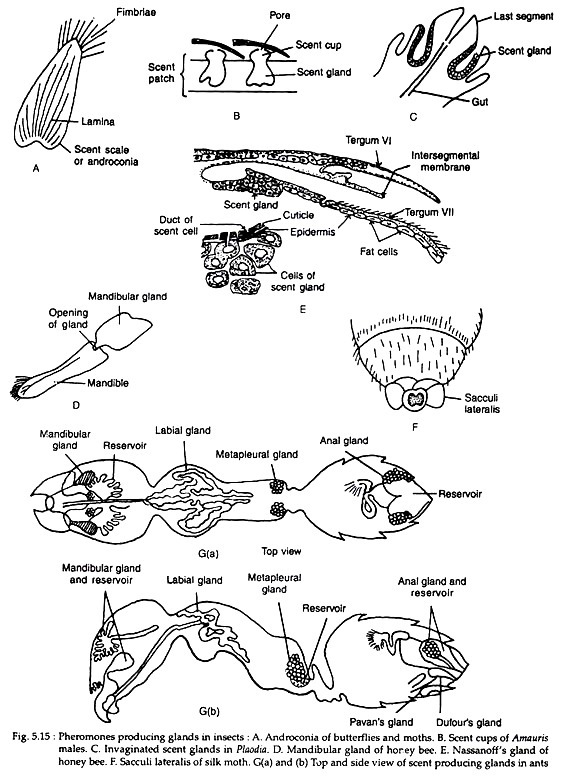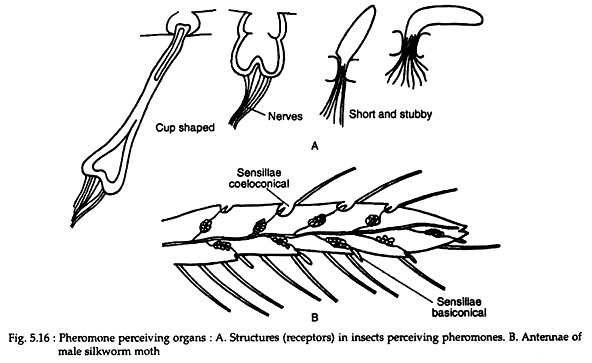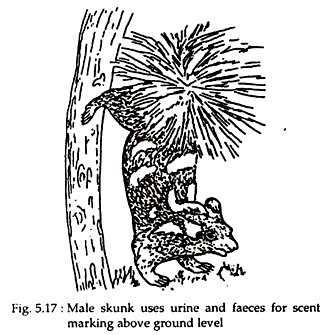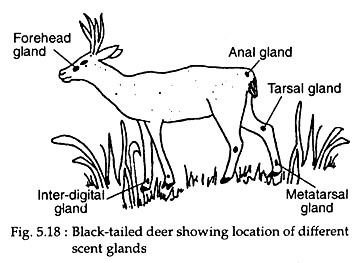In this article we will discuss about:- 1. Definition of Pheromones 2. Discovery of Pheromones 3. Classification 4. Chemical Nature 5. Pheromones in Animals 6. Functions 7. Adverse Effects.
Definition of Pheromones:
Communication among animals is essential for their well-being. Almost all animals communicate through chemicals produced by glands within the body. Pheromone is a chemical that is produced and released into the environment by an animal which affects the behaviour of another animal of the same species.
The word pheromone, coined by Karlson and Luscher (1959), is derived from two Greek words: pherein, to carry and harman, to excite. The term was originally applied to sex attractants of insects, but later it was broadened to include various kinds of chemicals released into the environment and functioning differently in almost all animals.
Pheromones are species-specific. They are generally hormones secreted by exocrine glands. Pheromones (also called ectohormones) are released in minute quantity bringing about major effect by functioning as chemical messengers and are used as chemo-signals in intraspecific communication.
Discovery of Pheromones:
ADVERTISEMENTS:
In the 18th century the discovery of pheromones took place by chance. A French biologist, Bonnet, discovered the long trail of ants. Bonnet placed a colony of ants at one end of a table and a small heap of sugar at the other end.
He observed that the ants coming out of the colony moved across the table to the pile, picking up sugar and moving back to the colony with it. The ants moved to and fro along a definite track, with none diverting from it (Fig. 5.14).
Bonnet wanted to know why the ants followed such a definite trail and so he broke the continuity of this path by rubbing his finger across the line of the ants. The ants stopped and searched about at the rubbed area. They waved their antennae in the air and tapped them on the ground. Gradually a crowd of ants accumulated on either side of the rubbed area.
ADVERTISEMENTS:
Subsequently, a few adventurous ants ran across the rubbed area. The ants of both the sides then met, recognised each other and continued with their journey once again. Bonnet thus inferred that the path of the ants was actually a trail of chemicals which the ants could sense and follow.
Classification of Pheromones:
Pheromones can be broadly classified into three types:
A. Releaser pheromones:
ADVERTISEMENTS:
Releaser pheromones induce immediate and reversible behavioural responses. It is mediated directly by the central nervous system and are used mainly in recognisation of species members, male and female sex attractant, sexual status, aggression inducer and inhibitor, ejection of milk, trail and alarm substances etc. Bronson (1971), instead of releaser pheromones, used the term signaling pheromones for such immediate motor responses.
A few example of releaser pheromones are:
1. Releaser pheromones in mammals are present in the urine and footpads. The pheromones in footpads initiate aggressive behaviour in a mouse on encountering an unfamiliar male. Urine of male mice, deer, dog, horses etc. contains releaser pheromones for attracting females or organising aggressive activity. Vaginal secretion of sheep, hamsters, rhesus monkeys etc. act as releaser pheromones.
2. The special flask-shaped cells of the skin of a fish produces alarm pheromones whenever it encounters an intruder. The fish is frightened by the odour of the intruder. Both marine and fresh-water fishes produce such alarm pheromones.
Whenever an antelope is frightened it produces alarm pheromones from large glands concealed in the fur on the sacral region of the body. Alarm pheromones in the form of formic acid are produced by ants from the abdomen to protect themselves from enemies.
Honey bees, while stinging an enemy, releases alarm pheromones along with poison. Immediately after stinging she moves to other fellow members of the colony to show her sting and flutter her wings to agitate the fellow members.
B. Priming Pheromones:
Priming pheromones produce a prolonged or long term endocrine or physiological responses in receivers mediated by the neuroendocrine pathways or through direct effects on the target organs. It triggers oestrogen and progesterone production that leads to oestrus (inducer or inhibitor), termination of pregnancy and sexual maturation cycle.
Some examples of priming pheromones are:
ADVERTISEMENTS:
1. If a number of female mice are caged together they affect each other’s oestrus cycles. This probably results from an odour passed on from one female to the other. When a male mouse is introduced into the cage it results in shortening of the oestrous cycle. This is due to the presence of pheromones in the urine of male mouse, which is thought to be an androgen (testosterone) metabolite.
2. Hilda Bruce discovered that a pregnant female mouse tended to abort if a strange male mouse was around and is exposed to its urine. This effect is called “Bruce effect”.
3. In ants, termites and honey bees, members of the same colony share a common pheromone which differs from that of the other colonies of the same species.
4. Queen honeybees generally preserve her monarchy by exuding a pheromone called queen substance which keeps worker bees sterile and inhibit them from making new royal chambers or queen cells.
5. The size of the colony and the cast system in case of termites, are regulated by pheromones, called social pheromones which is produced by a pair of reproductive termite (king and queen).
C. Imprinting Pheromones:
Imprinting pheromones act at critical period of developmental age. It causes permanent change in adult behaviour. This type of pheromones have been observed in some rodents (mice, rat etc.).
Chemical Nature of Pheromones:
Pheromones are chemical in nature. Chemical signals are particularly well- developed in insects and mammals. These chemical signals may be either volatile or nonvolatile. Some chemical signals are designed to last only for a short time and, hence, are volatile. They tend to have low molecular weights. Example of such volatile chemical signals are the chemicals used by ants to signal alarm which fades within a minute or even less.
Other type of chemical signals are designed to last for a longer time which allows a message to persist even in the absence of the signaller. Such chemical signals are said to be nonvolatile. Examples of such nonvolatile chemical signals are the territory marker pheronones of spotted hyaena which is secreted by sub-caudal scent glands.
Pheromones isolotation and extraction is a laborious work. The sex attractant of cockroaches (Periplaneta americana) was identified by Robert T. Yamomoto. He isolated it from a vapour emitted by female cockroaches, by running a stream of air through large cans containing thousands of females, for a period of eight months. The vapour was trapped by freezing it with dry ice.
From such laborious work Yamomoto was able to extract only 12-2 mg of pure sex attractants. This pheromone was identified as 2, 2-dimethyl 3-iso-propylidene cyclopropyl propionate, which is a volatile yellow coloured substance having a strong floral odour. Male cockroaches are attracted by this odour and respond by raising their wings and making mating attempts.
Similar type of work was also done on female silk moth (Bombyx mori), where from the abdomens of five million females only 12 mg of the pure pheromone, termed as bombykol, was obtained. Other attractants which has been extracted are gyplure (gypsy moth), queen substance (honey bee), civetone (civet), muskone (musk deer). The chemical composition of various pheromones extracted from different animals are listed in Table 5.3.
Pheromones in Animals:
1. Pheromones in Invertebrates:
A. Glands Producing Pheromones:
Pheromones are produced by definite glands. These glands vary in their structure and location on the body of animals.
Such glands producing pheromones are extensively studied in case of insects:
(a) In Locust:
Mature male locust (Schistocerca) through secretion of pheromones accelerate the maturation of other less matured locusts of either sex. This pheromone is secreted by the epidermal cells.
(b) In Lepidoptera:
The males of Lepidopteras (butterflies and moths) produce scent from glands known as androconia which are located in wings associated with scales. Androconia have a somewhat elongated structure and terminates in a row of fine processes called fimbriae (Fig. 5.15A). Pheromones produced by these glands evaporate through these fimbriae.
In queen butterfly, Danaus gilippus, pheromone is released by the male and brushed on the female by a pair of brush-like structure called hair pencils. These are present at the tip of the abdomen.
On each side of the hind wings of Amauris males, there are small scent patches. These patches contain highly modified structures called scent cups (Fig. 5.15B). These scent cups have a median pore and below the scent cup is present a scent gland. From these scent patches, scent is dispersed by scent brushes associated with genitalia.
In Plaodia, pheromones are secreted from invaginted glands which open on either sides of the last abdominal segment (Fig. 5.15C). By evagination of this gland, scent is dispersed. Female silk moth emits a sex pheromone called bombykol from a pair of sacs called sacculi lateralis (Fig. 5.15F). It is found on the last abdominal segment.
(c) In Hymenoptera:
(i) Honey bee:
In honey bee pheromones are liberated from two glands — mandibular and Nassanoff’s:
1. Mandibular gland:
Mandibular glands are located in the head region. It is a saclike structure and their duct opens at the base of the mandible (Fig. 5.15D). They are well-developed in the queen and workers but reduced in drones.
2. Nassanoff’s gland:
This gland was discovered in 1882 by a Russian biologist, after whom it was named. It is found below the inter-segmental membrane (arthrodial membrane) between the 6th and 7th abdominal segments. This gland is made up of a number of large cells which opens to the exterior by small ducts (Fig. 5.15E).
(ii) Ants:
Mainly pheromones control the social behaviour of ants as most of their signalling is by means of smell. Pheromones not only control mating in ants but also feeding and exploiting food, recruiting nest mates for battle, warning about enemies etc.
The total number of scent glands employed are numerous (Fig. 5.15G a and b) and all these scent glands are meaningful. Different kinds of ants leave pheromone trail from different pheromone- releasing organs. Fox example, trail pheromone is released by Solenopsis from its Pavan’s gland; in Myrmica from poison gland; in Lasius from rectal, gland.
The forager ant, after returning to the nest, uses another pheromone to recruit other ants to come and collect the food. For this purpose Myrmica rubra uses pheromone from its Dufour’s gland. If the food source is large and many workers are needed then Solenopsis releases mass-acting pheromones.
The pheromone of ants are released as a volatile liquid. The ants sense pheromones through their antennae and make continual use of both antennae to keep them in the right direction. They steer by balancing the pheromone concentration to the right and left. If the concentration increases to the left they turn to that direction until both antennae are sensing equal concentrations and thus guide the ants straight down the odour trail.
Recruit pheromones:
Recruit pheromones are not only used for collection of food, but are also used for recruiting armies for territorial disputes and in some species (Formica subintegra) for slave raids. Slave raids are coordinated by the pheromone from the ant’s Dufour’s gland, which are used to confuse the defending worker ants in the nest, that the attackers (slave-makers) raid.
After the slave ants have been brought to the nest, the ants now need to be able to distinguish their own teammates from members of other nests. This distinction is done by pheromones called colony odour. Each ant nest has its own distinctive odour.
Alarm pheromones:
Alarm pheromones are also secreted by ants to warn their nest mates about enemies.
On sensing the alarm pheromone an ant may:
(1) Run away from the source of the scent,
(2) Freeze and play dead, or
(3) Run towards the source of the scent and attack any nearby enemies.
Such different responses are probably stimulated by different alarm pheromones in ants. In case of weaver ant, Oceophylla longinoda, the diversity of messages in its alarm pheromones is due to over 30 different chemicals.
Thus, in weaver ant, the alarm pheromones stimulate a whole series of responses in its nest-mates. Another interesting pheromone is secreted by the larvae of driver ants of Africa called larval pheromone. This pheromone nurtures the larvae.
B. Structures Perceiving Pheromones:
Towards the end of eighteenth century, Auguste Forel, a Swiss ‘entomologist, reported various structures present on the ant’s antennae and on other insects which seem to be concerned with perceiving chemical substances.
These structures in insects were either flat or cup-shaped or in the form of short stubby hair (Fig. 5.16A). All these structures are supplied with nerves. The messages perceived by the specialised structures are sent to the central nervous system.
Certain animals have projecting antennae which are designed to perceive pheromones. The male silk moth receives the stimulus of pheromones by specialised structures located on the surface of its antennae. These are of two types — sensillae coeloconicae which are pit-like and sensillae basiconicae which are short rod-like (Fig. 5.16B). These structures act as chaemo-receptors.
2. Pheromones in Vertebrates:
A. In Reptiles:
Chemical trails are left behind by female garter snake which the male follows. The female snake, while moving, pushes against one side of certain objects and leaves behind scent in her direction of travel. The male snake tests each side of these objects with its forked tongue and recognises which side the female has pushed against.
B. In Mammals:
(a) Markings with urine and faeces:
Many mammals communicate through pheromones present in urine and/or faeces. These are used to scent mark a core area, home range or territory. Some animals also use urine and faeces to mark pathways, resting grounds, feeding grounds and sleeping sites. It is also used to mark rivals, opponents, defeated animals etc.
Different mammals utilise pheromones in the following ways:
1. Hippopotamus male marks its pathway between aquatic resting places and feeding grounds by depositing dung. This it does by defecating while walking on the trail by moving its tail rapidly from side to side. The faeces get splashed and deposited all over the vegetation above the ground level. Thus, the scent is placed at the nose height to make it more noticeable.
2. Male tigers select specific places and mark their territories with a pheromone called tiger-amine. It is a milky thick fluid with a strong smell and is passed out along with the urine.
3. Mainland serow (goat antelope) of family Bovidae, found in Northern India has fixed pathways which they mark by depositing its droppings. It can then just follow the scent and others are kept away.
4. Adult males of pronghorn and sambar mark their areas during their mating season with their droppings and urine.
5. Male skunk and giant rats place their droppings above ground level by standing on their forelimbs. Their hind limbs are raised above the ground and supported against some solid object they defaecate and urinate (Fig. 5.17).
6. Foxes, coyotes and dogs use only the urine to mark its territories. The pheromone present in the urine indicates various details such as individual’s identity, male or female, dominant or subdominant, adult or sub-adult and also how long ago that area was marked.
7. Two different methods are used by bear to mark their territory. They first mark a tree by scratching and chewing the bark and then they urinate on it to consolidate the marking.
8. Males of lion, leopard and other big and small cats mark their territories with pheromones present in the urine. They select some suitable object, turn their back to it, the back legs are extended and the tail is raised, as they urinate. The urine is released as a fine jet between the hind legs.
9. Some lemurs mark their territory by smearing their faeces on branches.
10. Greater bush baby, while urinating, places one hand which is half cupped in front of the urine and it is rubbed on the branches of the tree.
11. Adult members of capuchin (found in South Central America) soak their feet and hands in their urine, which is called “urine washing” and smear it on foliage. Such type of urine washing is also seen in slender loris.
12. Common squirrel monkey (found in Northern South America) demarcates its own territories by soaking its body especially tail in urine and smearing it on the leaves.
(b) Scent marking by special glands:
Use of pheromones through faeces and urine has its own limitation as because the user has no control over its production and release. This may be a probability which had led to the development of special gland producing pheromones. Such special glands have the advantage that the user can use it as and when needed. Many species of animals have evolved such special glands, which are:
(i) Anal glands:
The most common scent-producing glands are the anal glands. The animals possessing such glands are the monotremes, marsupials and a few placental mammals.
They rub their secretion on the ground or on objects to be marked:
1. Spiny anteater rubs its cloaca on the ground leaving a scent mark.
2. Male Tasmanian devil rubs its anal gland on objects such as stones, branches, ground and grass to protect his female and young ones.
3. The brush-tailed opossum and sugar glider have two types of cloacal glands with which they mark their nests.
4. The yellow-footed marsupial mouse rubs its cloacal secretion on twigs and branches around their small territory.
5. The black and red tamarin produces a strong smelling scent from its anal gland which keeps others away.
6. Two separate anal glands are present in the brown hyaena which are used for different messages. From these two anal glands secretion, as two separate pastes (one brown, the other white), are left next to each other on stalks of grass.
7. The male beaver marks dams, lodges and feeding trails with pheromones produced from his anal glands. It virtually keeps other male beavers out of his territory.
8. The ring-tailed lemur has scent glands in their forearms and anus. Both the males and females rub their glands to mark their territory. Males have additional scent glands under the chin and on the penis which secrete pheromones to attract females.
9. Brown hare of Europe lives solitarily and marks its territory with strong smelling secretions produced from anal glands. It also has glands around its face and inside its cheeks which are important to attract mates during the mating season.
(ii) Salivary glands:
Some mammals such as bears, dogs, pigs, rats etc. use saliva secreted from salivary glands as a marking agent.
1. Many marsupials deposit saliva on twigs by chewing them and thus marking the foliage of their territory.
2. Boar contains steroids in their saliva that induce a standing response which is essential for prolonged act of coitus.
3. A female rat deposits saliva on its nipples by licking them and leaving scent marks so that its blind pups can reach them.
(iii) Miscellaneous glands:
There are many other glands in mammals, the scent of which are used for marking.
They are:
1. The stags of Roe deer (found in Europe and northern Asia) mark their territories with secretions from glands present on the forehead, metacarpal as well as from urine and anal glands.
2. Black-tailed deer has five different scent-producing glands which are located at various parts of the body (Fig. 5.18). They produce different pheromones for different functions.
3. Male musk deer mark their territorial boundaries with scent secreted from a sac present on their belly, to attract females.
4. Black buck and sambar rub their facial glands, present just below the eyes, against trees present in its territory.
5. Thomson gazelles (found in Africa) mark their territory with scented tar-like substance produced by glands situated just below their eyes.
6. Bulls of elephants have temporal glands which produce a scent to indicate that they are ready to mate and are looking for a cow elephant in the breeding season.
7. Dominant male reindeer have scent glands between their hind toes, which help to leave scent trails for the remaining members of the herd.
8. In camels, scent glands are situated on the neck which are rubbed against the objects to be marked and play an important role in mating.
9. In marmots, scent glands occur between the eye and ear used for marking its territory and mates.
Functions of Pheromones:
Pheromones serve a number of functions for different animals:
I. In invertebrates:
A. Sex attractants:
Pheromones are employed by various animals to attract the other sex for mating.
(a) Pheromones of females:
Female insects usually releases pheromones by exposing the concerned glands. Generally they are released at particular time of the day, depending upon the diurnal or nocturnal nature of the animal. The scent thus released excite the approaching male and serves as a guide for reaching the female.
The queen bee attracts drone by releasing pheromones from two glands – mandibular and Nassanoff’s. The secretion of pheromones from these two glands serves her to rule over a colony of 6,000-8,000 individuals for a period of 5 to 7 years. The male Emperor moth (Endia parvonia) can detect the sex attractant of the female as far as 13 kms, although the female carries less than 0-001 part of a milligram.
(b) Pheromones of males:
Very few instances of male producing sex-attractant is present in the animal world. The male beetle, (Harpobittacus) from its posterior abdominal segments, releases a scent which excites female for mating. This it does while feeding upon a prey. When the female arrives, the male presents her with the remainder of the prey. While the female is busy eating, the male beetle copulates with her.
B. Communication in social insects:
Many ant species lay scent trails by which they find their way about. In case of fire ants, pheromones play a role in communication. The worker, after discovering a food source, returns back to the nest by laying a trail.
The forager ant, on encountering a fellow-worker, rushes towards it and tries to bring the trail substance to its notice. Initially the trail consists of a series of scent spots produced by the forager ant by touching the ground with its abdomen as it returns to its nest.
Subsequently, as more worker ants join the fray, the spots which they all produce may merge into a continuous trail. The trail of the fire ants is formed by substances secreted in minute amount from Dufour’s gland present in the abdominal edge.
The trail is not only used for leading to the food, but may be used for other purposes such as for routine passage or for emergency exit. Sometimes alarm pheromones from mandibular or anal gland attract other members of the colony, who come to its rescue.
In social insects the alarm pheromones perform three main functions:
1. To alert the colony
2. To release aggression
3. To mark the target to be attacked.
Pheromones are volatile. Pheromones used for marking trails or territory are less volatile, while distress pheromones are highly volatile. If one is stung by a bee and if by reflex the bee is killed, then the stinging of dead bee may release alarm and distress pheromones, which triggers a mass attack from the hive.
Worker bees are attracted towards each other by scent from Nassanoff’s gland.
The scent from this gland may be released in various situations, such as:
1. At the time of feeding,
2. During formation of new hive,
3. To mark a source of water,
4. To mark hive for recognition and
5. For maintaining cohesion of swarm during flight.
C. Maintenance of social structure:
(a) The queen bee produces pheromones which help in controlling the social structure of her colony. If the queen is removed or dies then the workers become restless and start building emergency queen cells or royal chambers. The larvae within these cells are fed with Royal jelly.
The queen which emerges first, stings the remaining sisters to death. However, in the presence of the queen, this behaviour of the workers of building new royal chambers is kept under control by a pheromone produced by the mandibular gland.
(b) The queens of certain Vespine wasps, who live in smaller colonies, produce pheromones that maintain the stability of the colony.
(c) In termites the number of a particular cast is regulated by a number of pheromones. In the absence of the queen, its replacement is produced within a week. In termites also more than one queen is produced. As soon as the first queen emerges, the rest of the developing queens are eaten up by the workers. Even when the old queen stops producing pheromones it is also eaten up by the workers.
D. Traping prey:
Some insects use pheromones to trap the prey. For example, bola spider tricks the male moths that are searching for mates. To attract the moths, the hola spider secretes a scent that is similar to the scent secreted by the female moth. The male moth comes near to the scent and is eaten up by the spider.
E. For pest control:
The species-specific quality of pheromones can be used to attract and capture designated target animals. For example, traps that contain the scent from female Japanese beetles can be used to attract males as a pest control procedure.
F. Inhibitory pheromones:
These are pheromones that inhibit the action of other pheromones produced by the same species. For example, Verbenon reduces the response of sex attractant pheromones of Dendroctonus (beetle). Thus, excessive aggregation of this species leading to overcrowding on the host plant is avoided.
II. In vertebrates:
A. Sense of belonging and self-confidence:
In animals, any new object is a source of unease until it has been made safe by marking. The scent of pheromones increases the self-confidence of animals. The African elephant, when facing a rival, during the breeding season, will sometimes turn his trunk and smell his own temporal gland. This appears to increase the elephant’s self- confidence.
B. Sexual behaviour:
Pheromones in sexual behaviour has two types of role:
(a) In marking the territories of male:
The territory is first acquired by fighting and then the males mark their territories with scent (by urinating) and ward off the rivals (Example: deer, antelope etc.) Territories are loaded with animal-scent indicating that no more fights are required for this particular territory. Male tigers, cats, dogs etc. tend to urinate to mark all possible objects which fall under its territory.
(b) Sex attractants:
They are used to attract the opposite sex for mating in most of the vertebrates.
C. Trail marking:
Like in the insects, vertebrates too mark their trail just to leave a record of their coming and going. This is to be read by themselves and subsequent visitors, as has been noticed in case of hippopotamus and rhinoceros.
These markings act as signposts and are regularly visited and inspected by neighbours. It helps each animal to keep a check on the movement of his fellows without actually seeing them. It also helps in conserving energy as they do not have to find the way afresh every time they move. Moreover, any intruder may be detected and challenged.
D. Avoiding interbreeding:
Recent studies on mice have shown the use of smell to distinguish mates that are genetically similar or genetically different from themselves. MHC (major histocompatibility complex) is a group of genes that were originally thought to be concerned with recognition of “foreign bodies”.
Presently it has been established that MHC not only affect cellular recognition but behaviour as well. Mice, therefore, can smell out mates that differ genetically from themselves and thus avoid interbreeding.
E. Marking fellow animals:
1. Male sometimes mark their mates with scent. For example, male rabbit marks his mates with his chin gland secretions.
2. A defeated rival in case of hamster are marked, who subsequently retreats. Mice and rats also mark a defeated opponent with urine.
3. A mother sniffs her newborn calf to form a permanent olfactory bond with her offspring. The calf also sniffs the odour of her mother.
4. Mammals such as bighorn sheep, dogs etc. often sniff and smell each other and through it they can probably know the sex, the group it belongs to and its readiness for mating. The readiness of a female is perceived by a male through pheromones produced from vagina. Pheromone copulin is produced from the vagina of a female rhesus monkey. Before mating, the male rhesus would sniff the vagina of a female.
F. Pheromones in the welfare of mankind:
Pheromones can be utilised for the welfare of mankind.
(a) In captive breeding:
Pheromones are useful in captive breeding of pet and wild animals. It also helps in the improvement of breeds of poultry, horses, cattle, dogs, pigs, goats, sheep etc. When a sow is in heat it recognises a boar by the scent emitted from his saliva.
For artificial insemination, if a person applies pressure on the back of a sow (which is generally applied by a mounting boar) and artificial pheromone of a boar is sprayed, then the sow allows the insertion of spiracle and semen.
(b) Controlling insect pests:
With the help of pheromones insect pest can be controlled in an eco-friendly way. By using artificially synthesised sex-attractant pheromones, harmful insects like mosquitoes, flies, cockroaches etc. can be eliminated. The use of aggregation pheromones can be done to attract the insect pests to come together and make groups. Thus, mass killing of insects can be done by applying these pheromones in a confined place.
Adverse Effects of Pheromones:
Pheromones sometimes have certain adverse effect on the user:
1. The pheromones produced by Anagasta larva induce the parasite, Venturia, to make probing movement with its ovipositor. This increases the larva getting parasitized.
2. Pheromones sometimes advertise the presence of an insect predator and potential parasite. The clerid beetle (Thanasimus dubius) is a predator of Dendroctonus (beetle). It thus is able to locate its host by responding to the pheromones frontalin secreted by the host.
